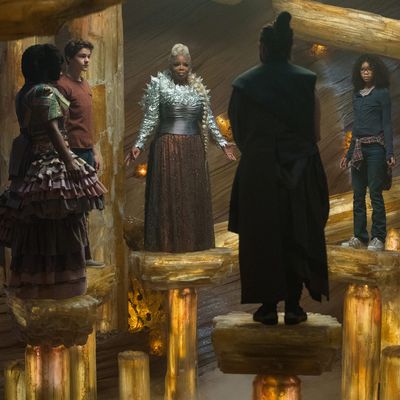
My elation on hearing that Ava DuVernay would direct Madeleine L’Engle’s classic 1962 time-and-space-traveling fantasy A Wrinkle in Time, was strong enough to carry me through the film’s first, wobbly 15 minutes — but not a lot further.
It’s not L’Engle’s world, but it’s one the author would have been thrilled by, at least at the outset: a jump through the eponymous time wrinkle from suburban Connecticut to a mixed-race family in an America in which the “IT” — L’Engle’s name for the dark matter that penetrates and dissolves human connections and works to shatter the young heroine’s self-possession — is manifest in almost every aspect of modern life.
DuVernay has cast the middle-school heroine, Meg Murry, with the intense, down-to-earth 14-year-old actress Storm Reid, whose Meg has every reason to be stormy. Her vaultingly ambitious scientist father (Chris Pine with a beard that crawls nearly into his blue eyes) has disappeared, leaving her only slightly less vaultingly ambitious scientist mother (Gugu Mbatha-Raw) pissed off and strangely uncommunicative.
Adding insult to injury are the oddly empathy-deficient peers who have made Meg a pariah and the dismally insensitive school administrators who think it’s about time she accepted that her dad isn’t coming back and gone about upping her GPA. Meg’s lone allies are her adopted 5-year-old brother, Charles Wallace (Deric McCabe), a cryptic genius of uncertain origin, and a handsome young fella named Calvin (Levi Miller), whose crush on Meg gives him something to play besides bland geniality.
The early scenes of A Wrinkle in Time — before we’re introduced to the “tesseract” and the spatial-temporal bounding begins — are relatively grounded, but only compared to what follows. They still have a trace of that theme-park-Disney wooziness, along with a score by Game of Throne’s Ramin Djawadi that’s off in the ether before the first astral being lands. That being — “Mrs. Whatsit” — is played by Reese Witherspoon, whose frilly gown is meant to look as if the character had invaded a high-school theater department’s costume room, but whose acting is less intentionally high-schoolish. Things pick up with the next entity, Mindy Kaling’s dreamy “Mrs. Who,” who spouts quotations from Rumi and Lin-Manuel Miranda before a giant pall descends on the movie in the form of Oprah Winfrey as “Mrs. Which.” When Winfrey’s Mrs. Which first shows up, she’s several sizes larger than her co-entities, which is symbolically apt.
In Middle of Nowhere and Selma, DuVernay’s path to her empowerment was rooted in the textures of real life, in the nuts-and-bolts of real time and real space. On the evidence, astrophysical abstraction isn’t her forte. She’s overawed, not by her source — L’Engle’s writing is dryly understated, an Einsteinian joke on classic myths and fairy tales, its three witches out of a Shakespeare stock company — but by the momentous responsibility thrust upon her. As the first African-American woman with a budget of $100 million, she seems to have set out to make the most empowering movie of all time. Transcendentally empowering. Oprah-level empowering. And that can really mess with your voice. The upshot is like a meditation sound bath, with phantasmagorical colors and Oprah herself intoning the empowering maxims. It’s a transcendental guidance counselor’s movie.
With Meg, her brother, and her quasi-boyfriend’s entry into the tesseract — a folded universe in which spatial-temporal constants are out the proverbial window — A Wrinkle in Time should rocket to life. I liked the flying flowers, the interior of what looks like a cosmic golf ball, and Meg’s descent to Earth on silken strands that might be a sort of visual pun on string theory. But the effects are never quite as awesome as they’re meant to be. I was going to say that a 5-year-old might be wowed, but not if she or he has spent any time with such truly consciousness-altering works as Boohbah and Teletubbies.
The movie doesn’t really come out of its New Age snooze until the Three Whatevers profess themselves too exhausted to continue and inform Meg and the others that they must face off against the IT by their lonesomes. In one sequence, the three find themselves staring at look-alike creamy stucco houses on a suburban cul-de-sac, each with a small child bouncing a ball in sync and a smiling, beckoning 1950s Leave It to Beaver mom. Scary, kids. Then it’s off to a white-sand beach where a garishly effusive Michael Peña welcomes the trio with sandwiches that prove to be disturbingly true to their name. Then comes the IT.
DuVernay doesn’t do the IT full justice, but she comes close enough to give us the willies, especially when it gets hold of the frighteningly articulate Charles Wallace. In this view, if space and time are an illusion and consciousness the only reality, then to explain mankind’s seemingly endless deficiencies (we really are a bunch of losers), there would have to be a universal force that acts to keep the self from realizing its full, transcendental potential. That’s the IT. The It “invades the place inside where hope and joy is.” It’s jealous. It’s racist. It’s greedy financiers. It’s Rotten Tomatoes.
From what I gather, film critics are not too happy about playing the IT in DuVernay’s tesseract and are bending over backward to stay true to the spirit of the times, as manifest in last Sunday’s Oscar ceremony. Most of us would like simply to praise A Wrinkle in Time for its multiracial cast, its multicultural soundtrack, and its ringing message of self-acceptance. Let me put a more positive spin on a negative review. The book is still out there for everyone to read: Please do so. And let’s welcome Ava DuVernay joyously back to Earth.


